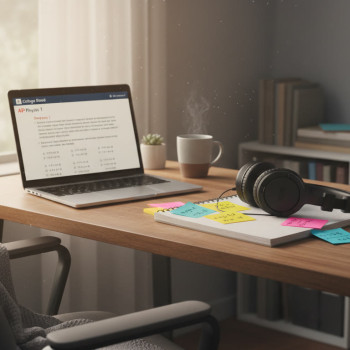Temptation Bundling: Pair Fun With Study to Ace Your APs
There’s a little secret behind sustained focus: you don’t have to suffer through study to get results. You just need to be smarter about how you pair things you want to do with things you need to do. Welcome to temptation bundling—a surprisingly sweet strategy for students tackling College Board AP exams. Whether you’re juggling multiple APs, balancing extracurriculars, or just trying to enjoy life while hitting your score goals, temptation bundling helps you study with momentum instead of guilt.

What Is Temptation Bundling (and Why It Works)
Temptation bundling is delightfully simple: you pair an action that’s good for your long-term goals but feels unpleasant (like reviewing AP Biology notes) with an activity you find genuinely enjoyable (listening to a favorite podcast, having a special snack, or watching a short episode of a show). The reward makes the chore more attractive; the chore gives structure to the reward.
Psychology explains why this works. We’re wired to prefer immediate rewards, which explains why scrolling social media beats completing a practice FRQ. Temptation bundling flips the script: the pleasurable immediate reward becomes contingent on the productive behavior. Over time, the brain begins to associate the claim “I study, then I enjoy,” which reduces friction and increases consistency. That consistency is the glue of exam preparation.
How Temptation Bundling Differs from Other Study Hacks
- Not punishment-driven: It’s not about denying fun; it’s about aligning fun with productivity.
- Behavioral, not purely motivational: It creates a structure that nudges you automatically toward the desired habit.
- Flexible: Works for quick study bursts or longer sessions—AP practice tests, flashcards, essay writing, and review can all be bundled.
How to Create Your Own Temptation Bundles
Don’t overcomplicate this. The most effective bundles are specific, realistic, and tied to a clear study goal. Here’s a quick guide to build your own bundles in three steps.
Step 1 — Choose a Study Task that Moves the Needle
- Pick tasks that are high-impact for AP prep: timed practice FRQs, active retrieval (flashcards), past-paper walkthroughs, revision of weak units.
- Break big tasks into bite-size chunks (25–45 minutes feels ideal for maintaining cognitive energy).
Step 2 — Pick a Reward That Feels Like Real Treat
- Choose something you look forward to but can make slightly conditional: a favorite snack, 20 minutes of a sitcom episode, a call with a friend, or a creative hobby session.
- Ensure the reward is easy to administer and not counterproductive (e.g., avoid rewards that derail sleep).
Step 3 — Make It Concrete and Trackable
- Write down the rule: e.g., “25 minutes of AP Chemistry flashcards → 15 minutes of guitar practice.”
- Use a checklist or habit tracker to record completed bundles; seeing streaks builds momentum.
Examples of High-Impact Temptation Bundles for AP Students
Below are practical examples tailored to common AP subjects and study scenarios. Use or adapt these directly into your weekly plan.
| AP Subject | Study Task (25–45 mins) | Reward (10–25 mins) | Why It Works |
|---|---|---|---|
| AP US History | Analyze one DBQ and outline a thesis + evidence | 15 minutes of a favorite podcast episode | DBQs need focused analysis; podcast is a passive, pleasant unwind. |
| AP Calculus AB | Complete and check 8 timed multiple-choice problems | 20-minute bike ride or game time | Physical activity resets the brain; solved problems feel rewarding. |
| AP Biology | Active recall of 15 key terms + drawing one process (e.g., glycolysis) | A small treat (favorite snack) and 10-minute music break | Visualization boosts memory; snack reinforces the habit. |
| AP English Literature | Write 300 words of a timed essay outline | Read one chapter of a leisure book or 20 mins of fanfiction | Writing sprints improve clarity; reading is the perfect literary reward. |
| AP Psychology | Create and test flashcards for 20 core experiments | Call a friend or watch one short video | Flashcards sharpen recall; social reward reinforces consistency. |
Daily and Weekly Temptation Bundling Schedules
Structure matters. Here are two templates you can copy into your planner—one for busy weekdays and one for deeper weekend study sessions.
Weekday Micro-Schedule (Fast and Sustainable)
- 5:00–5:30 PM — 25 minutes AP study + 5-minute review; Reward: 15-minute walk/listen to playlist.
- 7:45–8:30 PM — 40-minute focused practice (FRQ or problem set); Reward: 20 minutes streaming or creative hobby.
- Before bed — 10 minutes of light review (flashcards); Reward: 10 minutes of reading a fun book.
Why this works: Short, frequent bundles reduce resistance and fit around school, sports, and family time, making preparation consistent without burnout.
Weekend Deep Work Template (One Big Push)
- 10:00–11:30 AM — 90-minute practice test segment (timed). Reward: Brunch or 30 minutes social time.
- 2:00–3:30 PM — Targeted concept review and spaced repetition. Reward: 1 hour of a favorite pastime.
- 7:00–8:00 PM — Recap, create next week’s plan. Reward: Relaxed movie or special treat.
Why this works: Longer blocks are necessary for full practice tests and deep learning; pairing them with genuinely satisfying rewards makes a marathon feel manageable.
Common Pitfalls and How to Avoid Them
Temptation bundling is powerful, but only when applied thoughtfully. Here are frequent mistakes and easy fixes.
Pitfall 1 — Reward Is Too Big or Distracting
If the reward derails you (two-hour streaming binge), your productive behavior will lose its link to the reward. Solution: Keep rewards short and contained; use multiple small rewards rather than one huge one.
Pitfall 2 — Vague Rules
“I’ll study then watch TV” fails because “study” is vague. Solution: Make the study task measurable—“complete 30 practice questions” or “annotate two poetry passages.”
Pitfall 3 — Reward Is Independent of Progress
If you let yourself have the reward without actually doing the work, the bundle collapses. Solution: Add visible tracking—cross items off a checklist, take a quick photo of your completed problem set, or mark a calendar.
Use Tech to Support Your Bundles
Your phone can be temptation’s enemy or its ally. Use apps to enforce the rule and help you track progress:
- Timers (Pomodoro apps) for strict study/rewind splits.
- Habit trackers to visualize streaks—seeing progress is motivating.
- Focus apps to block distracting sites during study sessions, ensuring the reward is earned.
Smart Integration with Tutoring
One of the best ways to maximize the effectiveness of temptation bundling is to make sure your study tasks are high quality. That’s where personalized tutoring can shine. Sparkl’s 1-on-1 guidance and tailored study plans help you identify the most impactful tasks to pair with your rewards—so your bundles aren’t just more enjoyable, they’re more efficient. Expert tutors can set the right-sized goals for each session and provide AI-driven insights on weak areas, making the “study” part of your bundle precise and productive.
Real-World Examples: Students Who Made It Work
Stories stick. Imagine Maya and Jamal—two AP students who both used bundling differently but effectively:
- Maya: Struggled with AP Chemistry labs. She paired 40 minutes of targeted lab-report review (with her Sparkl tutor’s feedback) with a 20-minute comic-strip drawing session. She found the creative break helped her retain experimental setups and kept her studying three times per week without dread.
- Jamal: Wanted to improve his AP US History essay timing. He set a bundle: one timed DBQ/LEQ practice block followed by a 30-minute basketball pickup game. The physical outlet made him sharper and improved his ability to write under pressure.
Both focused on quality tasks and meaningful rewards; outcomes improved because they were consistent.
Measuring Success: What to Track
Temptation bundling is a behavior strategy, so measure what matters: consistency and learning gains.
- Track the number of completed bundles per week.
- Monitor practice test scores and time-on-task for targeted skills.
- Record retention via spaced repetition intervals (are cards remembered longer over time?).
- Note subjective metrics: stress levels, enjoyment, and energy—are you less burned out?
Simple Progress Table
| Week | Bundles Completed | Practice Test Change | Retention Improvement |
|---|---|---|---|
| 1 | 6 | – | Baseline |
| 4 | 20 | +3% | Noticeable |
| 8 | 35 | +8% | Marked |
Customizing Bundles to Your Personality
Not everyone experiences rewards the same way. Pick a style that suits you.
- Social Learners: Pair study with a live group check-in or short video call with friends as the reward.
- Creative Types: Use sketching, music, or journaling as a break to recharge.
- Active Students: Reward yourself with quick exercise bursts to keep energy high.
- Introverts: Quiet, restorative rewards like reading or painting can be most renewing.
Adapting Bundles for Different AP Exam Phases
Your needs change through the year. Temptation bundling should too.
Early Season (Foundations)
Focus: Build habits and cover broad content. Keep rewards small and frequent to cement consistency.
Mid-Season (Skill Building)
Focus: Strengthen weak areas with more structured practice. Rewards can be slightly larger—longer hobby sessions or social meetups.
Pre-Exam (Polish and Timing)
Focus: Full-length practices, timing, and stamina. Pair long tests with restorative, non-screen rewards (good sleep, favorite meal, intentional social time) to preserve test-day performance.
When Temptation Bundling Isn’t Working
If you try bundling and it doesn’t stick, don’t be discouraged—iterate.
- Check if the study task is too hard; split it further.
- Make the reward more appealing or easier to access but still limited.
- Try switching the time of day—some people study better in the morning and reward in the afternoon.
- If motivation is low, a short session with a tutor (Sparkl’s 1-on-1 support) can reset momentum and make follow-up bundles meaningful.

Final Checklist: Starting Your 4-Week Temptation Bundle Experiment
Ready to try? Here’s a checklist to guide a month-long trial that’s focused, measurable, and adjustable.
- Choose 2–3 study tasks that map directly to your AP goals.
- Pick 2–3 rewards that are genuinely motivating but containable.
- Set specific rules: durations, conditions, and tracking method.
- Record results weekly: bundles completed, practice score changes, how you felt.
- Adjust after two weeks: swap rewards or shrink/grow task lengths to improve adherence.
- Consider adding periodic tutoring check-ins—Sparkl’s tutors can help refine the study tasks so each bundle yields better learning returns.
Parting Thought: Make Studying a Life You Like
College Board AP exams are milestones, not the whole story. Temptation bundling doesn’t just make study tolerable—it can make it a sustainable, even enjoyable part of your routine. When study is paired with something you value, it becomes less of a chore and more of a rhythm. That rhythm keeps you moving forward: small, consistent wins that compound into readiness and confidence on test day.
Start small, pay attention to what actually motivates you, and adjust. Use clear tasks, meaningful rewards, and honest tracking. And when you need a nudge or expert guidance to make the most of your study time, personalized tutoring—like Sparkl’s 1-on-1 sessions and AI-driven insights—can help you design bundles that are both efficient and rewarding. Study smarter, enjoy the process, and let your progress be the reward that keeps giving.
Quick Starter Prompts
- What’s one AP task you’ve been avoiding? Pair it with a 20-minute reward you love and try it today.
- Set a 2-week goal: complete 20 bundles. Track daily—what changed in your focus and scores?
- If you’re unsure which tasks matter most, book a short tutoring session to prioritize your study list.
Good luck—you’ve got focus, a plan, and a little pleasure waiting on the other side of each study block. Temptation bundling turns “I should” into “I want to,” and that tiny change can make all the difference for your AP journey.




















No Comments
Leave a comment Cancel